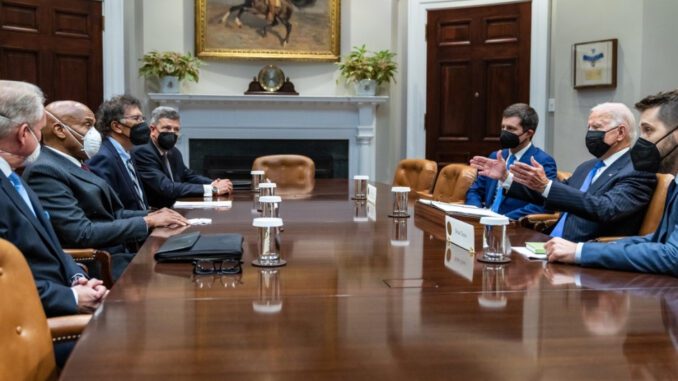
Estimated reading time: 11 minutes
Over 22,000 International Longshore and Warehouse Union (ILWU) dockworkers at major ports along the U.S. West Coast have been working without a contract since July 2022. They’ve continued working all throughout the COVID-19 pandemic, even as many “non-essential” industries ground to a halt, and kept the country’s supply chains open and stocked through a years-long crisis. Untold thousands of dockworkers — alongside untold millions of U.S. workers in other industries — paid the price in preventable infections, permanent debilitating medical conditions, and, in the worst cases, deaths.
Thanks to the workers’ sacrifices, their bosses, the owners, big shareholders, corporate executives, and high-level management of the big shipping firms, both U.S.-based and international, have made record-breaking profits during the COVID-19 pandemic. In that time, the stockholders’ and stockbrokers’ proverbial “line,” the rate of profit, has been consistently going up, with a record for shipping industry profits set in 2021 getting successively ”smashed” by last year’s margins.
Now these 22,000 and more workers want a contract. They want their wages raised to match inflation, expanded benefits and pensions, and job security. Their representatives have been negotiating with the shipping conglomerate capitalists, represented by the Pacific Maritime Association, an international shipping monopoly trust, since May 2022. Negotiations have been slow and painful.
Union representatives are vocally holding their ground. “We aren’t going to settle for an economic package that doesn’t recognize the heroic efforts and personal sacrifices of the ILWU workforce that lifted the shipping industry to record profits,” said the ILWU’s president Adams.
Holding their ground has historically paid off for the ILWU. Its workers are among the best-paid “blue collar” workers in the U.S., with full-timers earning a nearly $195,000 yearly income on average as of 2021. ILWU workers also receive “free” healthcare, large pensions, and other benefits. How have the ILWU workers won these gains? Their success owes partly to their tight organization and militancy, which goes down to the union’s roots: The ILWU was founded by Harry Bridges, a member of the Communist Party USA and a prolific labor organizer, who famously won a Supreme Court case against the federal government relating to his Communist activities. As a “red” union, the ILWU faced considerable state repression during the Cold War. The ILWU membership has also proven itself highly progressive: ILWU members regularly express solidarity with other union-organizing efforts and have also demonstrated and gone on strike against U.S. wars of imperialist aggression. In 2021, ILWU rank-and-file workers in Oakland, California refused to handle Israeli goods in solidarity with the Palestinian liberation struggle.
But the ILWU’s success also owes to its narrow exclusivity — an exclusivity that has been described as “gatekeeping” and even “aristocratic.” That’s a fundamental problem.
What are unions, and what is their purpose? A union is an organization of the working class, typically of the workers in a given industry or craft, who have recognized the need to combine as one collective force in order to struggle for concessions — higher wages, expanded benefits, safer working conditions, job security, etc. — from the bosses and managers. Unions are, at their best, not merely organizations of workers, but of the working class; unions are the elementary form of independent proletarian organization, and the economic struggle they wage is an elementary form of the proletariat’s class struggle against the capitalists. Unions are vital to the proletariat’s early development. For, as Lenin said, “in its struggle for power, the proletariat has no other weapon but organization.” Unions are organic vehicles of working-class power, and while they cannot be the “end,” they certainly are one vital beginning.
That is exactly why the ILWU’s model is fundamentally flawed. Rather than a vehicle to serve the organization of all workers in its industry (i.e., all dockworkers along the U.S. West Coast), the ILWU is tightly barricaded, and serves only as a vehicle of a highly privileged fraction of skilled longshoremen, clerks, and foremen. Rather than a vehicle for the collective power of the whole dockworking proletariat, the ILWU exclusively serves the dockworking labor aristocracy — that upper stratum of high-skill workers who, owing to their high-demand qualifications, enjoy much higher wages and other benefits, a much lower rate of exploitation, and much better living conditions than their low-skill (ergo replaceable) and consequently lower-paid, more intensely exploited, and precariously employed proletarian counterparts.
Employment as a longshoreman with ILWU membership is highly coveted by West Coast dockworkers. But the union’s closed-access policy means that membership can only be obtained by those workers who are highly skilled, have “put in their time,” and know the right people. It can take years, even decades, for a worker to obtain ILWU membership; often, a worker needs to know existing ILWU members to obtain the necessary references to be admitted. This is not the normal course for unions. The ILWU chooses to restrict its membership in this way.
Once a worker obtains membership, they are segregated into membership tiers — “Class A” workers, the longest-standing and highest-paid members, “Class B,” and “casuals,” who receive much lower wages, lack much of the benefits of their higher-tier fellows, and are not guaranteed the same hours. While the ILWU proudly boasts of the working and living conditions enjoyed by its Class A members — and rightly so — it is cagey about the conditions of “casuals” and other lower-tier members, refusing to publicly disclose such details to journalists as a matter of policy.
Is this any way to organize an industry, let alone the whole working class? The ILWU’s membership policy more resembles that of a medieval guild, an organization built to serve the journeymen, or the “aristocracy of labor,” at the expense of the novitiates and excluded workers, than an industrial, proletarian union, an all-embracing organization of proletarian solidarity.
Likewise, there’s something not-quite-proletarian in the ILWU leadership’s methods of struggle, and in the way it related to the rank-and-file membership.
On Thursday, June 2, talks came to a halt, as the PMA capitalists and ILWU reached an impasse over pay and benefits. The next day, industrial action began: The union workers shut down major ports and terminals in Los Angeles, Long Beach, and Oakland in California and Seattle and Tacoma in Washington, “effectively shutting down” and “severely impacting” productivity, according to the PMA bosses. The Friday shutdowns were followed by similar actions the next Monday, June 5, when union workers walked off their day shift, forcing the largest terminal at the Port of Long Beach to close.
The bosses are getting nervous — but not fearful enough to concede. Rather than return to the negotiating table, the PMA is calling on the Biden administration to step in on their side, and convince the ILWU bureaucrats to betray the rank-and-file members.
Meanwhile, some union workers are losing faith in the ILWU bureaucracy and its opaque policy of cloakroom deals with the PMA capitalists. Despite purportedly serving as their representatives, the bureaucrats have consistently refused to share any information on the ongoing PMA–ILWU negotiations with the union-worker membership. The ILWU has agreed to a policy of non-disclosure — typical in union negotiations, but absolutely anathema to internal democracy.
The ILWU workers are taking militant, fearless, well-organized action from below to fight for their demands. Yet their representatives in the ILWU’s top leadership are shutting them out and keeping them in the dark.
This lack of transparency is not some tactical necessity, nor is it an accident. Over the decades, ILWU bureaucracy has proven its ability to win gains for the union’s members, but it has done so largely by entering into a class-collaborationist alliance with the shipping industry capitalists and their bought-and-paid-for politicians in the Democratic Party. Behind closed doors — and even out in the open — they’re actually friends.
That’s why, for instance, back in October 2021, ILWU representatives met with President Biden, Vice President Harris, some of their cabinet, and various big businessmen for a cordial discussion that the union bureaucrats celebrated as a “historic White House meeting.” During a subsequent press conference, Biden personally thanked the ILWU’s president, Willie Adams, for doing his part to keep the workers working — and suffering disease and death — through the ongoing pandemic.
It is in this same spirit that Adams gave a glowing recommendation to Biden’s new Labor Secretary, Julie Su, while praising the administration’s outgoing Martin Walsh, who was instrumental in the Biden administration’s shameless betrayal of Rail Workers United in November. So much for Biden’s “most pro-union President in U.S. history” pledge! And so much for the cross-union solidarity so frequently preached by ILWU president Willie Adams.
At the end of the day, while they purportedly answer to and represent the union workers who elect them, the ILWU bureaucrats have more in common with the so-called “political class” in the federal and state governments than they have with their own union’s worker members. They would rather negotiate with the corporate executives, corporate attorneys, and other cronies who represent the interests of shipping industry magnates behind closed doors, shutting out the union rank-and-file; they would rather dictate a tentative agreement to the workers than seek the workers’ scrutiny, counsel, and approval on a democratic basis.
The opaqueness of the present negotiations, an attempt by the union bureaucracy to provide itself cover, in fact brings their collaborationist — we would say “opportunist” — character into stark relief.
Yes, the ILWU bureaucrats will flex their union’s militancy, the preparedness of the workers to take industrial action, to fight for their demands. Yes, the PMA bosses will get nervous, and call on President Biden to intervene. But at the end of the day, when the strike ends, the bosses and union bureaucrats will return to the negotiating table, eat calamari and lobster, drink whiskey, smoke cigars, and talk shop — shutting the workers out behind tightly locked doors.
Ultimately, it is the duty of the ILWU workers to extend solidarity to their fellow dockworkers, and their fellow workers in all industries — not only in the U.S., but the world over. They must demand that the ILWU open enrollment to all West Coast dockworkers. They must demand democratic transparency in ongoing negotiations from the ILWU top leadership. They must demand an end to the policy of class collaboration with the shipping industry magnates and their servants in Washington. And they must not wait — they must transform their union into a vehicle of the class struggle with their own hands, with their own voices, with their own workers’ democracy.
Many workers in U.S. shipping and transportation view ILWU members as a special class of labor aristocrats, who enjoy six-figure salaries, full benefits, stacked pensions, and ironclad job security to boot — and still demand more, even while the vast majority of transport workers are underpaid and overworked. In truth, the ILWU workers are right to demand more from the capitalists. But if the ILWU workers are not to be scorned as labor aristocrats by their fellow workers, then they must not rest content with exacting exceptionally privileged concessions from “their” capitalists. The ILWU workers, like the labor aristocracy in other industries, must take the initiative, and demand that their exceptional privileges be shared with the whole working class, from coast to coast, and in all countries.

